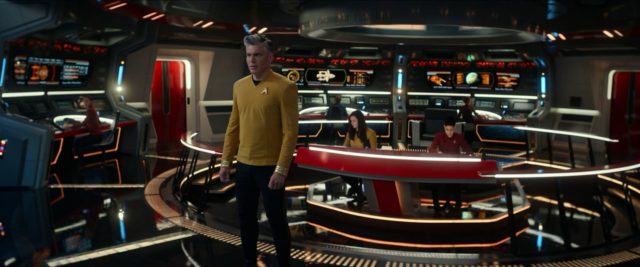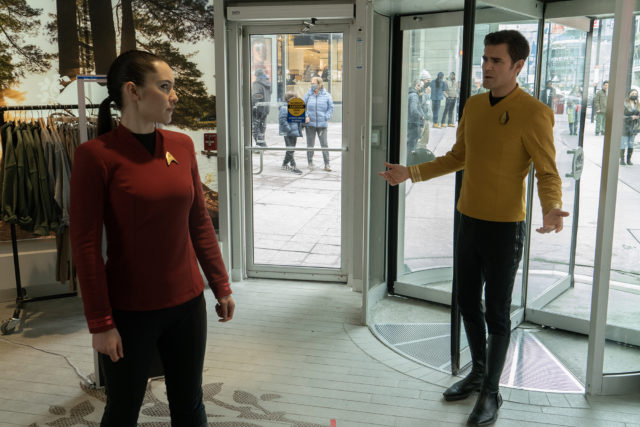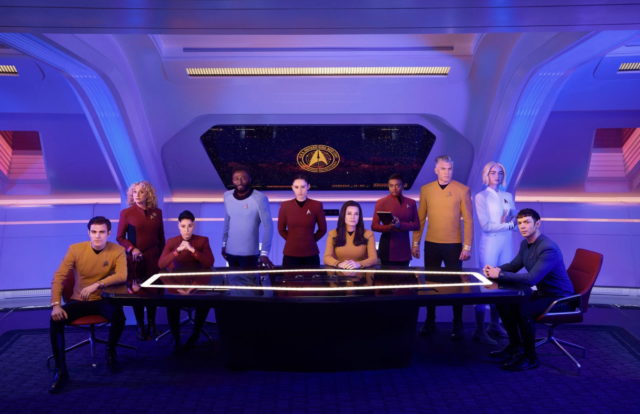Star Trek: Strange New Worlds is a spin-off from Star Trek: Discovery, in the second season of which Captain Christopher Pike (Anson Mount) takes command of the Discovery after the Enterprise has been damaged, and it wraps up with the two ships and their crews teaming up to save the day. This series takes place about 7 years before the original Star Trek series and chronicles the adventures adventures of the Enterprise under Pike, who is living with the knowledge that he is destined to be crippled saving several crewmen a few years in the future.
The elevator pitch for this series is basically, “If you want more of the original series, with better effects and updated for modern social sensibilities, then this is the show for you.” It’s not nearly as good at this – or as good overall – as the Star Trek: Year Five comic book, but it’s enjoyable.
Early on in watching this show I decided to embrace something someone suggested on Twitter: That each Star Trek series takes place in its own continuity, even though it pretends to maintain continuity with the other series. SNW has this quality in spades, with lots of nods to the original series, which don’t stand up to even casual examination. After enough continuity-jarring moments involving Spock or some other character or alien race who appeared in the original series exhibiting very different behavior or characteristics in SNW, it just becomes easier to treat the two shows as being in different continuities.
But once you get there the show is an enjoyable episodic sci-fi romp with a few excellent episodes and a few poor ones. The acting is stronger than usual for a Star Trek show. It still contains all the pseudoscientific nonsense one expects from Star Trek, there’s not much of an ongoing storyline, so it’s hard to get too invested or too disappointed.
Spoilery thoughts after the cut:
I’m not going to dwell on the things in the series I don’t like, but I will front-load my most negative thoughts.
Despite trying to see SNW as being in its own continuity, some things are so jarring that it takes real mental work to separate them. It’s easy to see Anton Mount’s Captain Pike as separate from Jeffrey Hunter’s: The two don’t look much alike and have very different acting styles, but it’s not a big leap to see Mount’s version as an older Captain who feels his career in the field is winding down and he’s trying to train the next generation of Starfleet to be the best they can be.
It’s a lot harder to see the portrayal of Spock and the Vulcans as having much similarity at all to the original series, or that there’s much benefit to what we do see. The tension between Spock’s emotions and stoicism is out there constantly, and I don’t fault Ethan Peck’s performance as Spock so much as the writing being weirdly obsessed with having Spock be emotional whenever possible rather than running with him as an emotionless foil to the other characters, as would be more in keeping with his early appearances (the one smile in “The Cage” notwithstanding).
(Aside: I’ve been sometimes referring to Peck’s version as “BuffSpock”, because he’s got to be the fittest Vulcan we’ve ever seen.)
This extends to other Vulcans we see, and while it’s not the only factor (the terrible sitcom-like scenarios are the big one), it is part of the reason that the two Vulcan-centered episodes, “Spock Amok” and “Charades”, are my two least favorite episodes of the series.
Similarly I mostly wish that they had created new characters instead of giving us younger and mostly-very-different versions of Uhura, Chapel, Scotty, etc. I think the stories would have been just as effective that way, and less distracting.
But to get to my favorite parts of the show, we turn to the one original series character I think works very well in SNW: Lieutenant James T. Kirk.
The season 1 finale, “A Quality of Mercy”, is maybe the best episode of that season. It’s a sort of time travel episode in which Pike sees what would happen if he avoids his foretold doom of being crippled by delta rays and retains command of the Enterprise. It replays the events of the original series episode “Balance of Terror”, except that Captain Kirk (Paul Wesley) shows up commanding the USS Farragut, and the encounter ends up going very badly compared to the original timeline. It’s a pretty good Pike-focused episode, but it felt at the time like this was just a one-off use of Kirk.
Instead it was just a warm-up for “Tomorrow and Tomorrow and Tomorrow”. Here the Enterprise‘s security chief La’an Noonian Singh (Christina Chong) is thrown into an alternate timeline where the Federation was never formed, and a young Kirk – a lieutenant in the main timeline – is captain of the Enterprise. A device throws both of them back to 2020s Toronto where they have to figure out what the catalyst for the difference in the timelines is. The episode is a welcome break from the usual “sent back in time to the viewers’ present day” story since it largely dispenses with the tired routine of the characters getting oriented to the past, and instead shows them taking practical steps to unraveling the mystery, then becoming friends bordering on more, before everything goes sideways, leaving the alternate Kirk dead and La’an shaken by the experience. Chong and Wesley both give excellent performances, and the story has a strong emotional resonance which is rare in Star Trek these days. It’s also the one time that La’an’s being descended from Khan comes into play in a real way.
(Another aside: At first I saw Chong as La’an as looking very much like Cara Gee as Carina Drummer in The Expanse. I think it was largely the make-up they both wear, though they both play their characters with a similar quiet intensity masking whatever they’re really feeling. I wonder if it’s a coincidence or if Chong was inspired by Gee’s performance.)
Anyway, the La’an/Kirk thread continues in “Lost in Translation” – co-written by David Reed, who wrote “Tomorrow and…” – which is primarily an Uhura story and is a pretty good one, even though it falls back on a tired Trek trope of mystery aliens our heroes can’t perceive trying to reach out to them. Wesley’s Kirk shows up again, and for whatever reason this episode really drove home what a fine acting job he’s giving in the role: While he doesn’t physically resemble them much, at different times I could see him giving a performance reminiscent of William Shatner and at other times of Chris Pine.
Kirk and La’an reconnect again in the musical theater episode, “Subspace Rhapsody”, in which La’an fills Kirk in on their history together – or rather, her history with his alternate self – and he confesses that his girlfriend, Carol Marcus, is pregnant, pretty much dashing any hopes La’an had. The scene is reasonably done but feels shoehorned into a much more flamboyant story, and I wish they’d deferred it to another time. Still, overall the arc was rewarding, not just for the acting, but for the build up, the sense of closure (even if not a very happy one for La’an), and for treating both of them like adults. Kirk’s relationships with women have become the butt of plenty of jokes (even though it’s really an undeserved reputation), so seeing him handled differently in this way was great.
Anyway, La’an is pretty solidly my favorite character on the show as a result of this, and I hope they do more with her next season.
The show has had a few fan-favorite episodes which have overshadowed the rest of the season. “Subspace Rhapsody” was probably the highest-profile of these. I thought it was fine, its basic conceit was over-the-top in a way which justified the story, but obviously it wasn’t the high point of the series for me. I enjoyed it more than the first season’s “The Elysian Kingdom”, which had some pretty costumes but also a pretty forgettable story. And there was also “Those Old Scientists”, a crossover of sorts with the animated Lower Decks series, also got a lot of attention and was pretty entertaining, although not as effective a time travel story as “Tomorrow and…”.
The second season ended on a cliffhanger, with the return of the Gorn, threats to a bunch of the crew, threats to Pike’s girlfriend, and the possibility of a new war with a new enemy. It was certainly plenty tense, although I found the set-up largely pretty contrived.
Overall I’ve been enjoying the show, though it’s been a bumpy ride at times. It’s decided not to go the large-story-arc-per-season route, which is fine – when the stories are as weak as those in Discovery then you haven’t really gained much by having them. If they’re building to anything, presumably it’s Pike’s fate as see in “The Menagerie” in the original series, but I don’t think it really has to be building to anything. I expect I’ll be back for next season – assuming the Hollywood strikes don’t torpedo the show.



